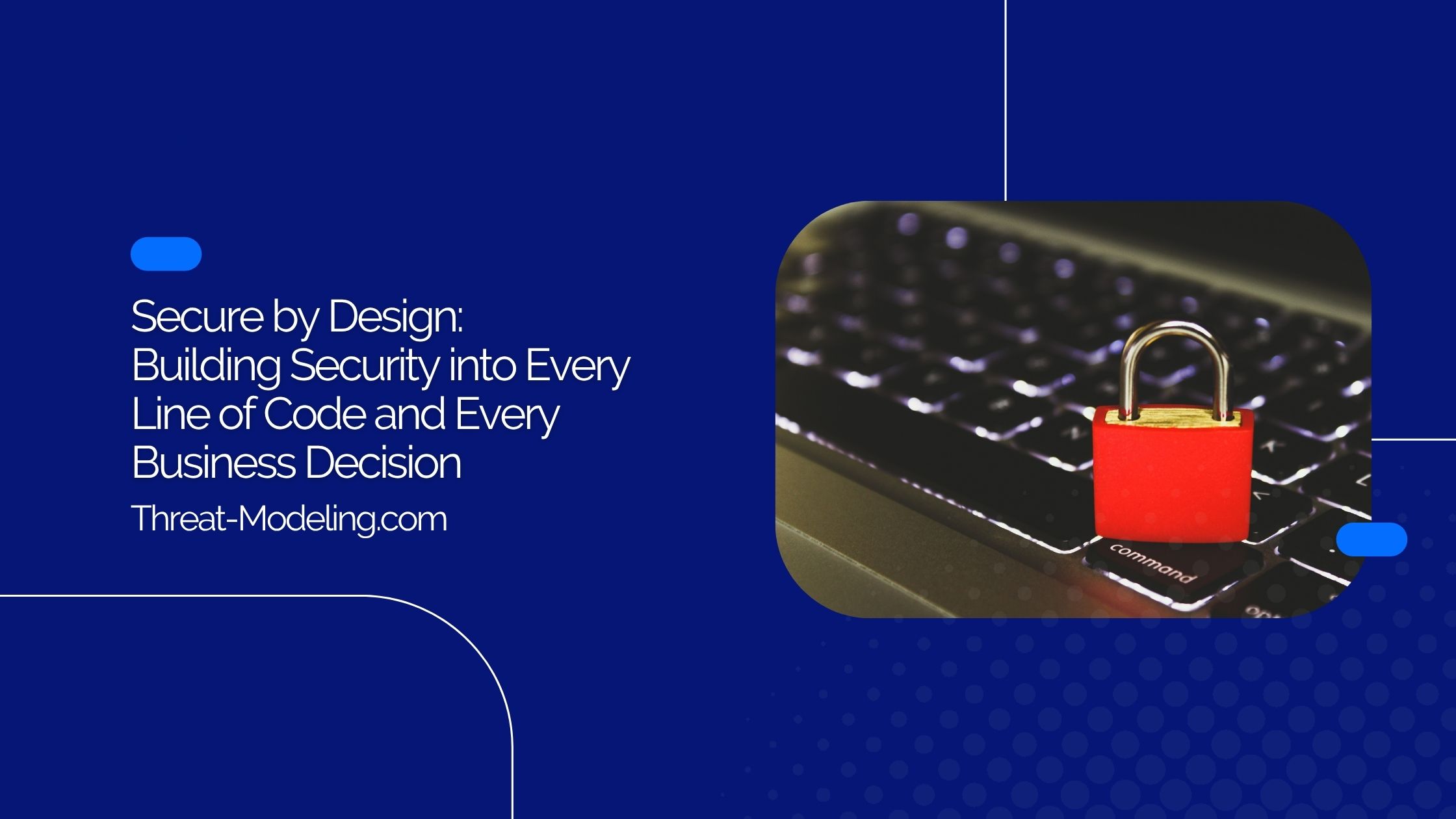What It Means to Be Secure by Design
Secure by Design (or Security by Design) is more than a buzzword; it is a philosophy that shifts security from an afterthought to the foundation upon which digital products, services, and processes are built. Picture a modern skyscraper: you would not stack floors into the clouds and only later wonder about wind resistance or fire escapes. By the same token, Secure by Design insists that security considerations be poured into the concrete, threaded through the steel, and wired into the very circuits of an organization’s technology landscape.
In practical terms, being Secure by Design means viewing every requirement, line of code, user story, and infrastructure diagram through a security lens. It asks development and operations teams to consider potential weaknesses before they become exploitable vulnerabilities. It nudges product managers to balance feature velocity with responsible risk reduction. And it encourages executives to champion security as an enabler of trust rather than a mere compliance checkbox.
This philosophy guards against the false comfort of patch-after-release culture. Instead of reacting to weaknesses after customers have already placed their trust in an application, organizations that embrace Secure by Design proactively identify threats, implement controls, and cultivate a culture of continuous assurance. They embed security practices into every stage of the software development life cycle, from requirements gathering to retirement, thereby reducing future remediation costs, minimizing breach impact, and safeguarding brand reputation.
The Secure by Design Pledge
A growing number of technology leaders and organizations publicly commit to a Secure by Design pledge. The pledge typically contains three pillars. The first is a promise to integrate security early and often, starting at the concept stage and following through to deployment and maintenance. The second focuses on transparency: openly sharing best practices, threat intelligence, and security outcomes so peers can collectively raise the bar. The third pillar revolves around accountability: measuring progress, reporting on key security metrics, and accepting responsibility when controls fall short.
Signing a formal pledge does more than create a catchy tweet. It galvanizes teams, clarifies expectations, and provides a tangible benchmark that stakeholders, customers, regulators, and partners can reference when evaluating an organization’s security posture. By vocalizing a Secure by Design commitment, companies turn an internal value into a public promise. The result is a virtuous loop of accountability, continuous improvement, and market trust.
How to Implement Secure by Design
Implementing Secure by Design involves weaving security threads into three broad workstreams: technological, procedural, and cultural. From a technological standpoint, organizations adopt secure coding standards, automated testing, and hardened infrastructure. Procedurally, they integrate security checkpoints into agile sprints or DevOps pipelines, think static and dynamic analysis, dependency scanning, and configuration validation, so issues surface early and often. Culturally, they cultivate a shared sense of ownership, where engineers, architects, product owners, and executives recognize that security is everyone’s job, not a siloed function sitting off to the side.
Successful implementation starts with discovery. Teams build a holistic inventory of assets, data flows, and dependencies, because you can protect only what you know. They then conduct risk assessments that prioritize the most critical assets, ensuring effort aligns with the impact. Next, they define secure development standards: clear guidelines on encryption, error handling, input validation, and third-party library selection. By codifying these expectations, organizations remove ambiguity and keep teams focused on what matters.
Automation is the backbone of high-velocity security. Continuous integration tools run linting and static analysis with every commit. Continuous delivery pipelines incorporate security gates that halt deployments if severity thresholds are breached. Infrastructure-as-code templates embed network segmentation, role-based access controls, and logging defaults. What emerges is a repeatable, reliable mechanism to bake security into every build and release, even as developers move fast.
Finally, feedback loops close the circle. Post-incident reviews, vulnerability trend dashboards, and threat intelligence briefs keep everyone aware of emerging risks and lessons learned. Armed with data, teams refine practices, update controls, and address systemic gaps, turning Secure by Design into a living, breathing discipline rather than a one-time checklist.
How Threat Modeling Helps with Secure by Design
Threat modeling, such as STRIDE, PASTA, or LINDDUN, is the compass that guides organizations toward practical, targeted security measures. By examining a system’s architecture, data flows, and trust boundaries, teams identify potential attackers, attack paths, and possible defenses before code is even written. This proactive analysis translates abstract risk into concrete technical tasks, such as adding input validation or segregating sensitive workloads.
In a Secure by Design environment, threat modeling sessions typically happen early, often during the architecture or backlog grooming phase. Cross-functional teams gather developers, security engineers, and product managers to map assets and think like adversaries. They challenge assumptions by asking, “What can go wrong?” and “How might a determined attacker exploit this feature?” These conversations uncover scenarios that static checklists might miss, such as privilege escalation through intertwined microservices or data leakage across multi-tenant databases.
Once risks are documented, teams prioritize them using criteria such as likelihood and impact. They then define mitigations, track them as user stories or tasks, and verify implementation during subsequent testing cycles. The outcome is not only a more secure product but also a workforce that understands threats and integrates security thinking into day-to-day decisions. Over time, threat modeling knowledge compounds: as patterns emerge and solutions repeat, the organization develops reusable threat libraries and hardened architectural blueprints, accelerating future design work.
Principles of Secure by Design
Least Privileges
The principle of least privilege dictates that any user, service, or process should have only the permissions essential to perform its duties, not one bit more. When applied rigorously, least privilege curbs the blast radius of compromised credentials and reduces opportunities for lateral movement inside a network. In practice, this might involve fine-grained permission models, just-in-time credential provisioning, and automatic privilege revocation when tasks complete or roles change.
Segregation of Duties
While least privileges limits access per entity, segregation of duties separates critical tasks among multiple entities to prevent fraud, error, or abuse. For instance, the individual who writes code should not be the lone approver for pushing that code into production, and the person who approves a finance transaction should not be the same person who reconciles it. This division creates oversight and forces collusion to execute malicious acts, thereby raising the difficulty bar for would-be attackers.
Defense in Depth
Defense in Depth recognizes that no single control is foolproof. Instead, security is layered, and network firewalls, application gateways, web application firewalls, endpoint detection, data encryption, and anomaly detection all contribute overlapping safeguards. Even if one layer fails or is bypassed, subsequent layers stand ready to detect or block the intrusion. The result is a resilient architecture where weaknesses in one area do not immediately translate into complete system compromise.
Advanced Identity and Access Management
Identity is the new perimeter. Modern Secure by Design strategies lean heavily on multi-factor authentication (MFA), context-aware access policies, and continuous authentication techniques. These tools ensure that users are who they say they are and that access decisions adapt to changing circumstances, such as suspicious geolocation or impossible travel. A robust identity program also simplifies onboarding and off-boarding, further reinforcing least privileges and segregation of duties.
Security Logging & Monitoring
Comprehensive logging and real-time monitoring transform security events into actionable intelligence. Detailed logs capture who did what, when, and from where, providing incident responders with the breadcrumbs needed to reconstruct timelines and contain breaches. Equally important, monitoring pipelines equipped with machine learning or rule-based detections can surface anomalies in near-real-time, cutting mean time to detect and mean time to respond. Together, logging and monitoring complete the feedback loop essential to any Secure by Design practice, ensuring that controls work as intended and that lessons from incidents feed directly into future improvements.
Challenges of Secure by Design
Getting Teams Involved
One of the first roadblocks organizations face is ensuring that every team, from engineering to operations to customer support, feels responsible for security outcomes. Traditional silos, where security is “someone else’s problem,” are deeply rooted. To break these habits, leadership must provide clear expectations, ongoing education, and the right incentives. Gamified training, transparent security metrics, and recognition of secure engineering achievements help build a shared sense of purpose.
Persuading the Business Departments
Product managers and line-of-business leaders often balance a relentless feature roadmap against limited budgets and tough timelines. Security controls can look like speed bumps on the path to market. Explaining Secure by Design in purely technical jargon rarely wins hearts or budgets. Instead, framing security as a customer trust enabler, a brand differentiator, and a risk-reduction strategy tied to bottom-line impact resonates more convincingly. When business stakeholders understand the cost of downtime, breach notification, fines, and reputational damage, they view security investments as insurance rather than an expense.
Getting Management Buy-In
Senior leadership sets the tone. Without executive sponsorship, Secure by Design initiatives risk becoming side projects that crumble under delivery pressure. Obtaining genuine buy-in involves translating technical requirements into strategic objectives—revenue protection, market expansion, regulatory compliance, or competitive advantage. Executives must also allocate resources, from budgets and headcount to dedicated time in sprint backlogs. Regular reporting on security posture, tied to clear Key Performance Indicators and Key Risk Indicators, keeps leaders informed and engaged, preventing Secure by Design from fading into background noise.
Another obstacle lies in measuring return on security investment. Unlike revenue metrics that skyrocket after feature releases, security ROI is often invisible—breaches that never happen, fines that never materialize. To close this perception gap, organizations leverage risk quantification models and scenario analyses. Showing leadership how a single security lapse could cost millions in incident response and legal fees reframes security controls as cost avoidance rather than discretionary spend.
A Forward-Looking Conclusion
Secure by Design is not mere jargon, it is the structural integrity of modern digital products and services. By grounding every requirement, architectural sketch, and production deployment in security principles, organizations minimize risk, reduce remediation costs, and safeguard customer trust. A public pledge cements accountability, while practical implementation threads security into technology, processes, and culture.
Threat modeling serves as the flashlight that illuminates hidden attack paths, allowing teams to strengthen defenses before malicious actors can exploit them. Core principles—least privileges, segregation of duties, defense in depth, advanced identity management, and relentless logging—provide the guardrails that keep systems safe even as complexity grows.
Challenges persist. Rallying cross-functional teams, persuading business units, and earning executive endorsement require persistence, communication, and clear value articulation. Yet, as the digital economy accelerates and threat landscapes evolve, the cost of ignoring Secure by Design only rises. Organizations that embrace this philosophy find themselves not merely surviving but thriving, delivering faster innovation, stronger customer loyalty, and a resilient posture in an uncertain world.
Ultimately, Secure by Design is both a mindset and a muscle. The more diligently it is practiced, the more natural it becomes. Teams learn, iterate, and improve, gradually transforming security from a bolt-on accessory into a defining characteristic of quality. When that transformation takes hold, companies gain a competitive edge built on confidence: confidence that their products stand strong, their data remains protected, and their customers rest easy, safe in the knowledge that security was woven in from day one.
Related articles:


